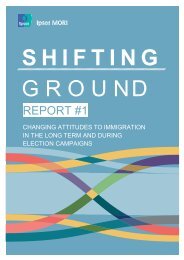You also want an ePaper? Increase the reach of your titles
YUMPU automatically turns print PDFs into web optimized ePapers that Google loves.
Ties <strong>that</strong> Bind<br />
238 Ibid, pp.70-72<br />
239 Ibid.<br />
240 Ibid, p.32<br />
54 | policyexchange.org.uk<br />
the British Army. He was neither an NCO nor a Warrant Officer, and despite his<br />
length of service, was always junior to any ICO. Few VCOs spoke English, and their<br />
primary role was to forge the link between the NCOs and the officers. Although<br />
an Indian regiment would have been composed of companies of Sikhs, Muslims<br />
and Hindus, the VCO for each company would have been of the same race or<br />
religion as the men in <strong>that</strong> particular company. However, these officers were<br />
drawn from all classes and religions, and command units were made up of men<br />
of every sect. 238 This accelerated social and administrative development forced<br />
modernisation and ‘Indianisation’ sooner than it otherwise would have.<br />
The high number of Muslims in the Indian Army meant <strong>that</strong> they flourished<br />
under this officer scheme – a factor also aided by their ‘martial race’<br />
categorisation. One of the martial races, the Pathans, was described by an<br />
American journalist as ‘a fierce tribal people whose profession is war’. 239<br />
Table 4: Class composition of Indian infantry as percentage<br />
Caste Hindus Mussalmans Sikhs Others (including<br />
Scheduled Caste)<br />
1 Punjab 50% 50% – –<br />
2 Punjab 33.3% 33.3% 33.3% –<br />
Madras 50% 25% – 25%<br />
Indian Grenadiers 50% 50% – –<br />
Mahratta Light Infantry 100% – – –<br />
Rajput Rifle 66.6% 33.% – –<br />
Rajput 50% 50% – –<br />
8 Punjab 50% 50% – –<br />
Jat 50% 50% – –<br />
Baluch 25% 75% – –<br />
Sikh – 25% 75% –<br />
Frontier Force Regiment 25% 50% 25% –<br />
Frontier Force Rifle 25% 50% 25% –<br />
14 Punjab 25% 50% 25% –<br />
15 Punjab 25% 50% 25% –<br />
16 Punjab 33.3% 33.3% 33.3% –<br />
Dogra 100% – – –<br />
Ram Garh Rifle 100% – – –<br />
Kumaon 100% – – –<br />
Assam – – – 100%<br />
Sikh Light Infantry – – 100% –<br />
Mahar – – – 100%<br />
Bihar – – – 100%<br />
The seamlessness with which the Indian Army managed this transition<br />
surprised external observers. The New York Herald Tribune described India as ‘a<br />
confused medley of race, religion and language’ which ‘militates at the outset<br />
against the formation of a large force, drawn from the population at large’. 240<br />
There seemed to be genuine surprise at the Indian Army’s ability to bring together<br />
the largely disparate forces of the Raj and unify them within a single unit. But the<br />
paper overstated the case when it suggested the Indian Army had ‘contributed to<br />
the breakdown of caste and religious barriers without offending the principles



